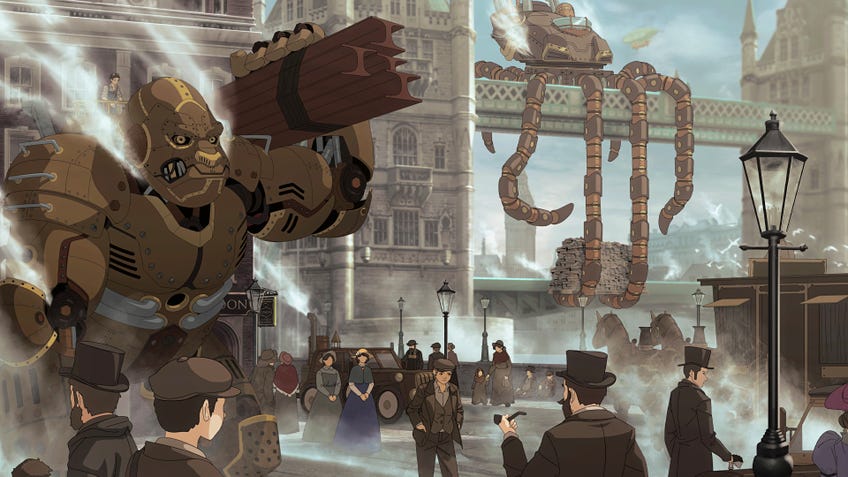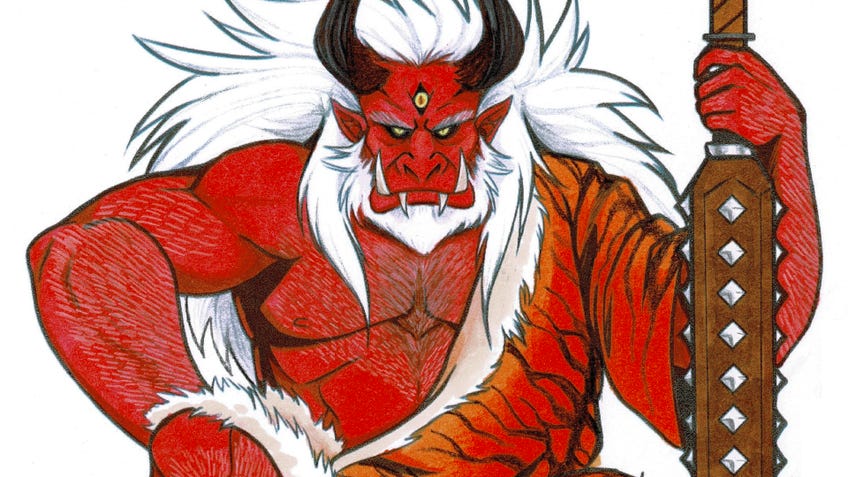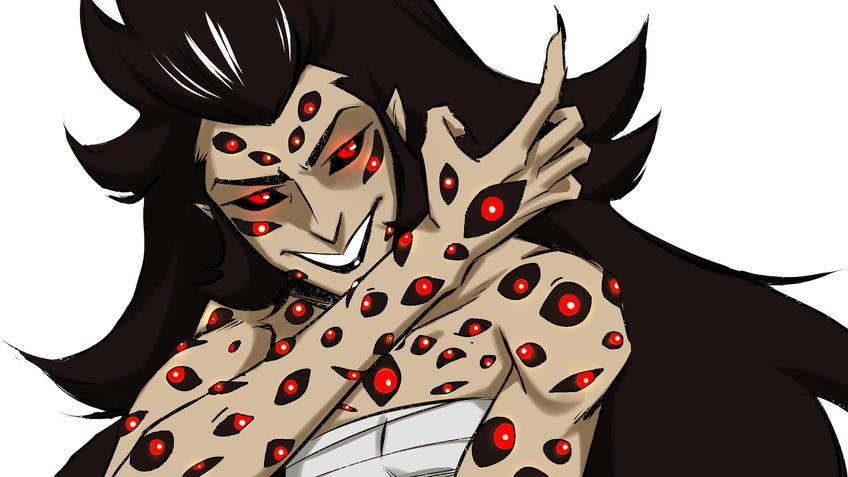Cyberpunk and Witcher designer’s next RPG is about multiverse-hopping ninja inspired by Naruto, Stargate and Japanese myth
Teased as Project Blue Moon over the summer, Shadow Scar will feature an original setting and a brand new gameplay system.
The creator of The Witcher tabletop RPG and co-designer of Cyberpunk Red is working on a new roleplaying game with an original system and setting. Dicebreaker can exclusively reveal the name and first details of the upcoming RPG previously codenamed Project Blue Moon.
Shadow Scar is the first wholly original tabletop RPG from Cody Pondsmith, lead designer for The Witcher Pen & Paper RPG and co-designer of Cyberpunk Red, the latest edition of Mike Pondsmith’s seminal ‘80s RPG. (Which has been adapted into a video game by Witcher developer CD Projekt Red, along with accompanying Netflix anime series Edgerunners.)
Rather than utilising the Interlock system on which The Witcher and Cyberpunk were built, Shadow Scar will use a new system called the Mosaic system - named after the multiversal setting of the game. The dice pool system uses only six-sided dice, with players gathering a number of d6 determined by the combined skill and stat used for the test. Any results of three or more are a success, with sixes counting as two successes; getting the required number of successes passes the test.
“This will not be in the same kind of line as Witcher or Cyberpunk where it is a lot crunchier,” Pondsmith told Dicebreaker in an exclusive interview. “It is intended to be something that you can pick up more quickly and play very, very quickly. Not fully rules-light, but a lighter experience.”
Podnsmith originally designed Shadow Scar running on Interlock, but swapped to a custom system early in the game’s development to help capture its distinctly different feel.
“My ethos as a game designer, or what have you, is that the system informs the game,” Pondsmith explained. “Whatever game you're playing, the system will always give you the fundamentals of what the game feels like. I have often felt that a game should have a unique system if it's going to have a unique feeling. So it diverged from Interlock pretty quickly, as I started to develop new ideas and things like that.
“[There are] a few little tricks here and there that we're putting in, specifically for this world and this system.”

Shadow Scar centres on the titular Shadow Scar Agency, a secretive organisation whose agents are tasked with protecting the multiple worlds of the Mosaic from the invasion of interdimensional monsters.
Four of the Mosaic's worlds will be detailed in Shadow Scar’s core rulebook, with Pondsmith expressing a desire to find the balance between “making an 800-page rulebook that had a chapter for every dimension or a 300-page rulebook that had one page about every dimension”.
“We have these multiple dimensions and I wanted to really make them all feel unique,” the designer said. “I'm focusing as much as possible on quality over quantity, which is why every world has a full chapter breakdown.”

The monsters players will encounter on their adventures have their origins in Nakatsukuni, a high-fantasy world influenced by 17th-century Japan and Japanese folklore. Following a century of warfare against an invasion from the underworld of Yomi-no-kuni led by Izanami, the Japanese goddess of the dead, the inhabitants of Nakatsukuni tear a rift in reality - the eponymous Shadow Scar - and cast monstrous yokai, ghostly yūrei and other beings drawn from Japanese mythology into the void, unwittingly spreading them across other worlds in the multiverse.
The monsters - many of which have been drawn directly from the Kojiki, the influential eight-century Japanese text - will be detailed in a bestiary in Shadow Scar's core rulebook, which Pondsmith says will outweigh the bestiary for The Witcher TRPG.
“I have always found Japanese myth to be so different from a lot of other mythos - in that so many of the creatures in Japanese myth are less terrifying and more weird,” Pondsmith said. It's things like goblins that lick grime off of dirty toilets and spectral creatures that don't really do anything other than walk behind you at night and freak you out.
“In Shadow Scar, all of those creatures have been bound to the will of an evil deity - so they're all enemies. But we've had a very interesting time rendering a lot of this wide variety of weird monsters into enemies that all have their own interactions on a table, as well as their weird traditional lore as to what they were before they were taken over by this entity.”

“We're attempting to reach out to folks,” Pondsmith added when asked whether cultural consultants would contribute to the RPG's deep influences from Japanese folklore, culture and mythology. “We have some people that we're talking to about cultural consulting for the Japanese setting - especially because so much of the game is set in there - who have been wonderful so far. And we will continue to bother as we get closer to release on things.
“Primarily, it's me at the moment, just because we're kind of laying down the foundation. I'm excited to bring in other people for future products. But the first product we have to have one very unified vision so that we can lay everything out, and then hand it to other people and feel confident that they're gonna get the right feeling.”
The other worlds affected by the outcome of Nakatsukuni’s 100 Years of Sorrow include Fifth Street, a pulp noir setting set in a larger-than-life take on pre-Great Depression America. The 1920s setting adds a meta layer known as the Narrative, an in-world director-like presence that transforms the world as if it were a film come to life - with rain pouring during moments of sorrow and environmental sounds forming into a suitable score for the characters’ action.
The steampunk world of Steel Court instead draws from mid-19th-century Europe, imagining a British industrial revolution that used the fantasy technology to triumph during the first Napoleonic War. The British Empire subsequently formed out of the majority of Western Europe sparks unease and conflict ahead of the First World War, from a different perspective than our own reality.
The last world detailed in Shadow Scar’s core book will be Refuge. Unlike the other worlds, Refuge looks ahead to an alternate-history 2030s split from our timeline by a different outcome to the Cuban Missile Crisis that resulted in a stockpile of nuclear missiles exploding. The focus of Refuge is a lunar colony created by the United Nations as a safeguard against humanity’s destruction in nuclear war, whose inhabitants are cut off from Earth by the invasion of the multidimensional monsters. The few humans on the Moon are left as the last remnants of humanity, having to decide whether to try and reclaim the Earth or settle another planet in order to survive.

As well as the futuristic lineage from his time on Cyberpunk, Pondsmith acknowledged the influence of Shinichirō Watanabe and Keiko Nobumoto’s sci-fi western anime Cowboy Bebop on the setting of Refuge, one of several anime the designer credited as inspiring the “heavily anime-based RPG”, alongside ninja classic Naruto, modern smash-hit Demon Slayer, and Watanabe and Shinji Obara’s hip-hop samurai gem Samurai Champloo.
“This is a passion project of mine that I've been working on for the majority of my life,” Pondsmith said. “I have pulled from a lot of anime that I've watched over the years, just as this world has evolved and shifted as I have been working on it.”
The influence of Naruto and other ninja anime include Basilisk is seen in the game’s equivalent of RPG classes, with each character trained by one of six schools of ninjutsu - something Pondsmith compares to both the shinobi clans of Naruto and the distinct monster-slaying schools of The Witcher.
Those ninjutsu clans provide unique techniques, from the power to influence others through an aura of authority to physical traits, such as sharpened claws able to inflict bleeding damage, the superhuman power to glide on the wind and magical ability to breath fire or shoot lightning.
The techniques are combined with abilities defined by the character’s home dimension, such as the increased luck during rolls of those from Fifth Street via the Lady Luck trait, providing character customisation on top of a simple trio of stats in Mind, Body and Spirit. As characters complete missions, they will rank up from starting Shinobi, earning new abilities and powers.

The ninja-like role of characters extends to a dedicated assassinate ability, inspired by the challenging direct combat of video game series Tenchu that encouraged players to instead eliminate enemies using stealth. In Shadow Scar, players can get the drop on foes and roll one or two dice - depending on the enemy’s ranking - to try and silently take them out.
The stealthy approach comes with its own risks, though, in that failed assassinations can alert every enemy in the area. On top of that, Pondsmith says that enemy characters have almost identical abilities to player characters, allowing them to sneak up on unsuspecting players if they’re not careful.
“The game itself is not a directly combat game,” Pondsmith said, “I almost think of it more like a puzzle game. It is more akin to the old Tenchu games where you get a goal and you have an environment you're going into to solve that goal, kind of Hitman-like; how are you going to get to your target and kill them and then get out again?”
If players are killed, rather than being gone for good, their character’s essence wanders a spirit plane parallel to the material world. The spirit realm has its own inhabitants, with characters able to negotiate with the lesser deities of the kami to influence the material world and still needing to fend off attacks from ghostly yūrei. The spirits of dead characters can be carried by their companions in a spirit lantern, potentially being resurrected back at the agency’s headquarters using the power of the gods.

The inspirations from both traditional Japanese folklore and modern anime and video games combine in the traversal of the Mosaic itself, as players’ agents step through torii gates - like those seen outside Shinto shrines - within the gatehouse of the Shadow Scar Agency’s castle headquarters to instantly move between worlds, in a method Pondsmith compares to sci-fi series Stargate.
When simple travel isn’t possible, characters can risk rift-diving - a dangerous way of moving between worlds used by yokai and rogue Shadow Scar agents that sees characters tear new holes in reality to leap between worlds. That comes with the risk of ending up off-course in an unexpected dimension - including uncharted worlds - or even outside of reality, suffering the existential overload of witnessing the infinite multiverse of the Mosaic in its entirety.
Those uncharted dimensions could even include worlds from other tabletop RPGs or settings, with Pondsmith encouraging players to bring in their own homebrew creations to Shadow Scar.
“The only really systematic aspect of the dimensions is if you want to play a character from those dimensions, there are three homeland abilities that you get. But we're actually giving guidance on how you can make homeland abilities for your own dimension, so you can play characters from your own dimensions,” he said.
“We very actively want people to be like, 'Okay, I have this setting that I really love. So, today, you guys are deploying to an unknown dimension for the agency to find out what's going on. So you're gonna play these next two sessions in this world that I created or this game that I also love, or what have you.'
“While we will expand on that multiverse later, we want to encourage people to expand on that multiverse themselves and homebrew in their own worlds and things like that.”
While most campaigns will see players moving between many dimensions - sometimes multiple times in a single session as they pursue targets - Shadow Scar will allow for focused exploration of a single world in a gameplay variant called Vanguard Teams. The alternate setup creates a hideout for a group of agents all from a single dimension, rather than across the multiverse, and sees them dealing with monsters that pop up in their home world without venturing further into the Mosaic - akin to Men in Black, X-Files or Kingsmen.
Pondsmith said that while ideas for Shadow Scar had amassed throughout his whole life and he had run private sessions “for years”, the game started to “be a real thing” around 2016. The recently announced hiatus for The Witcher Tabletop RPG caused by CD Projekt Red’s ongoing development of The Witcher 4 was a “big push” in Shadow Scar finally entering full development last year.
Without committing to a release date (“I try not to say due dates because things can happen…”), Pondsmith said that the “intention” is that Shadow Scar will release in 2024. Like Cyberpunk Red, the core rulebook will be preceded by a quickstart-type starter set earlier in the year, with accompanying miniatures and accessories also in the works for a fuller release later in 2024 if all goes to plan.
“We're really taking this opportunity to push the envelope a little on how much support product and whatnot we usually do for games,” Pondsmith said.

As for what comes beyond that core book, Pondsmith hopes to expand on the worlds and inhabitants of the Mosaic - including new playable species on top of human agents - in the future.
“What I've tried to do is effectively set it up so that we have a very tight core to focus on in the core book,” the designer said. “Then as we build on it, I want to bring in other worlds. I have five or six other worlds that I'm planning to bring in later that will bring in weirder things as we find humans in dimensions where humanity has mutated somewhat and dimensions where there are more than one sapient species.
“The core is we set up a very basic concept, and then branch off from there as we go, building up on top of it.”
For now, Pondsmith is focused on finally putting his lifelong passion project out into the world, before looking ahead to what comes next.
“That is a truly tremendous amount of work to write down everything that I've been scribbling for the past six years or whatever.”



